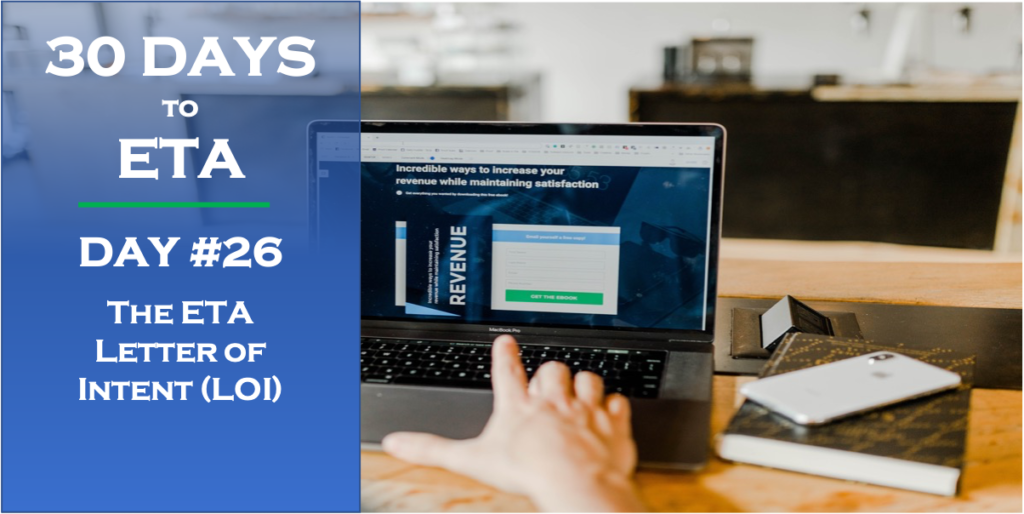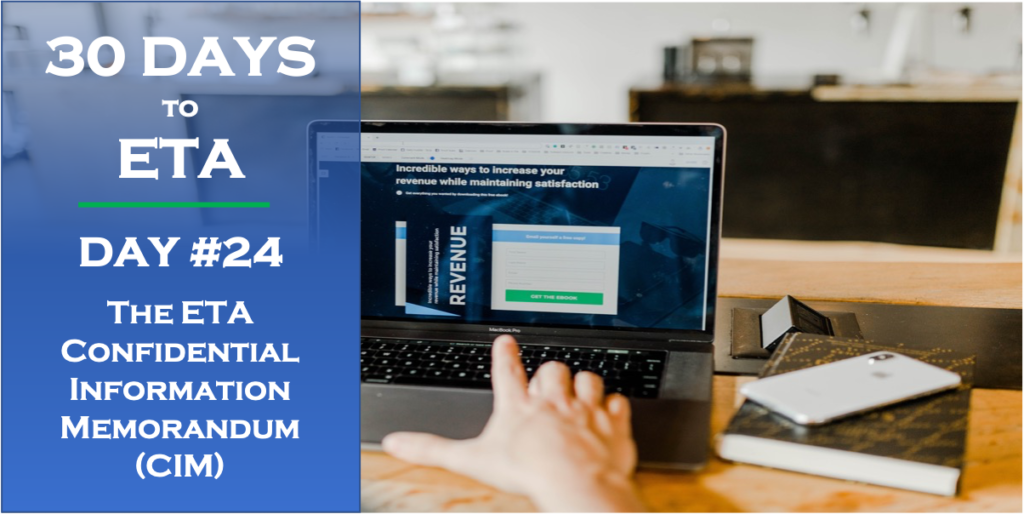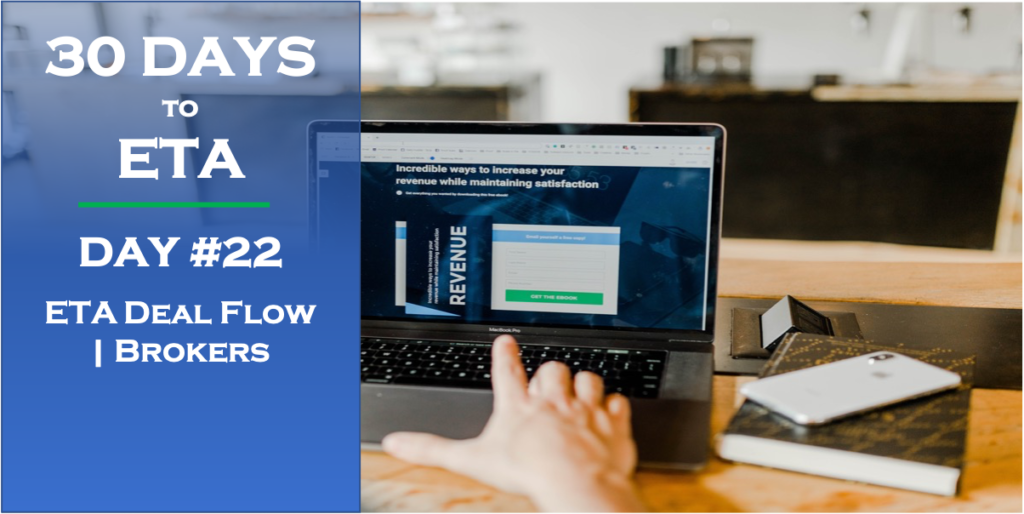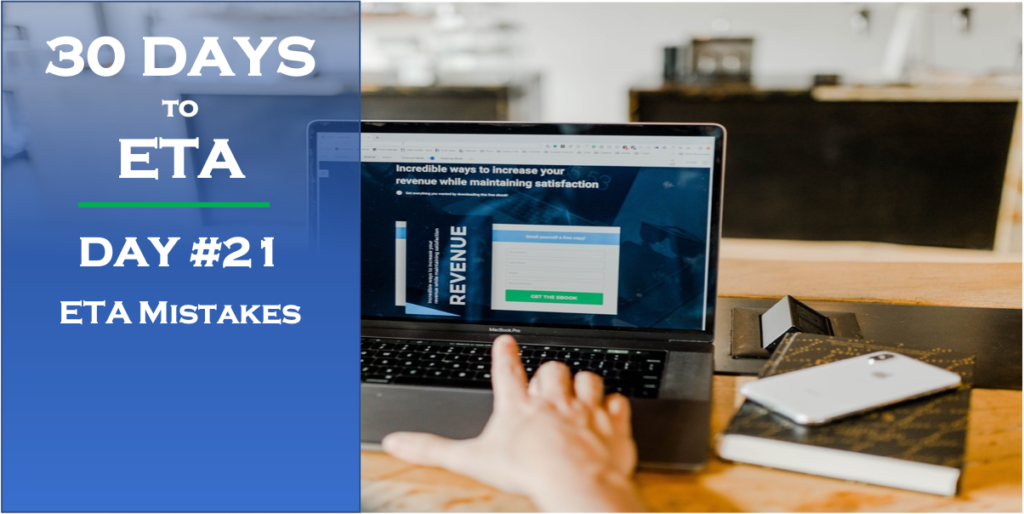If you’ve been reading along in this 30 Days to ETA series, you know that in the Day #26 post I shared as an Entrepreneur Through Acquisition (ETA), finding, researching, conducting preliminary due diligence — as well as interviews — are all precursor to what is considered by most to be the first step in the formal business sale, the ETA Letter of Intent – LOI (You can read the previous post by CLICKING HERE). Now that you have the found the business and the ownership vision is in sight, how are you going to fund it to make it a reality? So, in today’s 30 Days to ETA post, we’re going to explore ETA Capital… Enjoy!

ETA Capital – 5 Sources
When I think about our Mergers & Acquisitions practice at Tip of the Spear Ventures, the decisions that we make when it comes time to purchase a business generally fall within the confines of a financial decision. One of the mentors that I have in the capital space told me years ago that in order to successfully acquire a business, you have to bring capital. I couldn’t agree with him more! But how much and in what form?
The following represents five sources of ETA Capital that you should consider as an Acquisition Entrepreneur. These five sources fit regardless of whether or not you are breaking-off a piece of your Balance Sheet or going out and securing a debt instrument. NOTE – Entrepreneurship Through Acquisition is risky. Don’t believe for a second that because the business you are exploring has provided an income for the previous owner that the business under your new leadership will continue to do so — Especially in the early goings. Why do I share this? See the SUMMARY at the conclusion…
There has never been a time when capital is so inexpensive… Leverage your cash position accordingly!
Sam Palazzolo, Managing Director @ Tip of the Spear Ventures
ETA Capital Source #1 – Cash
The first way to acquire a business is to buy it with cash. Most likely, this is the way you expect to get paid when you sell your company when that time comes, right? However, this is the least likely ETA Capital sourcing event to occur. Why, I mean after all isn’t cash king? Of course cash is king, but with the cost of money so inexpensive, why would you want to put all of your cash to work in one place?
I have a capital mentor who is famous for telling me that with all those benjamins in the bank, the goal is to get those benjamins out into the economy and make little baby benjamins! It’s a good visual way of saying put your money to work for you, and I’ve grasped the concept since the day he shared it with me.
So while cash is king, it also like a king needs a heredity line of offspring to go forward with. So the ETA Capital Source of Cash should be your least likely way of funding your ETA Mergers & Acquisitions.
ETA Capital Source #2 – Stocks
Secondly, buyers and sellers can use one of two types of stock buy-out methods to pay for a business upon the sale. For these stock methods to work, the business must operate as a C Corporation or an S Corporation (technically an LLC taxed as a C or S is also allowed) that can buy, sell, and trade company stock. Remember our discussion about business operations and entities back in 30 Days to ETA post #11 – Entity Formation (You can read the post by CLICKING HERE)? This is where your chosen entity can affect your future sellability. If you’re not sure which business entity to choose or you’re not sure how your business operations affect your sellability, go back to that post.
Before we leave the ETA Capital Source topic of Stocks, let’s take a deeper dive into Employee Stock Ownership Plans (ESOP) and Stock Buy-Outs:
An Employee Stock Ownership Plan (ESOP)
What if you want to leverage the employees of the organization and make all of you owners of the business you are acquiring? Enter the Employee Stock Ownership Plan (ESOP). To buy a business through an ESOP in its simplest terms, you must hire an independent evaluator to place a value on the company’s stock. Once the value is determined, you hire a trustee to set up and operate an independent trust. At that point, the trust buys stock shares from you based on the purchase price the evaluator set. Employees, then, have the option to purchase company stock from the trust, which will hold the stock as long as the employee works for the company. When an employee leaves or retires, he can sell the stock back to the trust at a fair market value.
While the ESOP can get very complicated, it has a lot of advantages. Essentially, this is a way an owner can remain with the company while taking the capital out of the company. If the owner doesn’t want to retire in the immediate future, they can set up an ESOP. Then, they continue to partially run the organization until they’re fully paid or have sold all of their stock shares back to the trust.
Another good thing about an ESOP is that it benefits and rewards long-term employees. The ESOP creates a long-term initiative and loyalty program that rewards employee commitment and hard work. It incentivizes employees to drive the company towards success because they own portions of it. The more valuable your stock in the company becomes, the more money they get when they sell!
An ESOP is not for every corporation, though. Some entrepreneurs don’t like having a third party evaluate company shares. Many feel that the valuation is lower than what they would receive for their stocks on the open market. Another disadvantage of the ESOP is that the company has to have cash. You have to keep a fair amount of cash on hand so that when an employee leaves, you can convert their stocks to cash and pay-out that particular person’s shares.
Stock Buy-Outs
The second method of stocks as an ETA Capital source is stock buy-outs. These stock buy-outs can get complicated, so I’ll try to make it as simple as possible. To generate additional capital or to retire from the business, the owner of the company can sell their company stock. As in an ESOP, you’ll want to hire an independent valuator to place a value on those stocks. As the ETA, you can then purchase the majority of their shares, all of their shares, or portions of them. In doing so, you become shareholders/owners in the company and have rights to elect directors and vote on company policies. However, the previous owner may have the option to keep some of the company’s stock, depending on how you set the stock buy-out up. Thus, they can maintain some control of the business and receive immediate cash capital.
Let’s assume as the ETA you buy the company and as the majority shareholder drive the business to unprecedented success. Consequently, all shares increase in value, making everyone who owns stock lots and lots of money. With hopes this will happen, you want to add a provision into the stock sale agreement that allows you to buy additional shares at set terms, such as at the price the shares were valued upon the sale of the business.
Conversely, what if as the Acquisition Entrepreneur you drive the company into the ground? What if the value of your stocks plummet? You must have provisions written into the sales agreement which allows you to purchase additional shares at the same value majority owners can or sell them to other owners at a predetermined set price.
Another provision you want to address in stock buy-outs is a tag-along right. In other words, if as the buyer you purchase the majority of the company shares for $10 and then find a buyer to pay $20 for them, make sure you can include your shares in that deal. You want to “tag-along” on that sale and get that $20 per share.
Lastly, make sure you address piggyback rights in a stock buy-out. If as the buyer you ultimately make the shares public, you’ll want to address the right to publicly register shares. Most sellers will want the right to “piggyback” on your success.
ETA Capital Source #3 – EarnOut
Here is a definition of ETA Capital Source #3 – Earnout from Investopedia:
“An earnout is a contractual provision stating that the seller of a business is to obtain additional compensation in the future if the business achieves certain financial goals, which are usually stated as a percentage of gross sales or earnings.”
Essentially, this allows you as the buyer to give the seller a fair price for their company now, but gives the seller the bonus if they think it’s worth more later on if/when the business does well. For example, say the company has $5,000,000 in sales and $500,000 in earnings. As the ETA you identify that you wants to pay $2,500,000 for the company, but the seller think that’s too low (Of course). The seller counters that the company will drastically increase in sales because of some groundwork they have laid (Perhaps a robust sales pipeline or backlog of their book of business). For both parties to agree, you enter into an earnout or a compromise. In this example, you pay the $2.5 Million up front as a deposit on the business. Then, you agree to give an additional $2.5 Million IF the company reaches $10,000,000 in sales over a three year period. If the company doesn’t reach a certain amount of sales, you don’t have to pay the seller any additional money. Or, you can add in a provision that you will owe the seller “$X” more at the end of three years dependent on a predetermined earnout scale for growth.
Using the same $5,000,000 and $500,000 from our example, let’s say you pay the seller $2,500,000 up front. Instead of asking for an additional $2,5000,000 IF the company reaches a certain amount of sales, the seller asks for a guaranteed 5% of the company’s gross sales over the next three years. Then, and only then, if the business makes $10,000,000 in three years, you owe the seller an additional $500,000 per year for the 3-year term. If the business makes $20,000,000, the seller earns another million per year of the 3-year earnout term.
An earnout can offer the seller a handsome reward if the company is who they say that it is. We’ve gone through LOI and typically identified that there is no way the business’ sales pipeline is anything but fiction. If we had gone through with the Purchase Agreement, it would have left the seller with nothing other than the down payment and us with the debt associated with structuring that down payment. So be wary, and protect yourself. Know the seller’s nonfiction reality before you choose to exercise an earnout option.
ETA Capital Source #4 – Seller Carried Note
A great option for buyers, Owner Financing may be the best option for sellers.
Different than an earnout, you and the seller agree on the company’s worth. You cannot or will not come up with the cash to cover the entire purchase price or even the down payment. Typically, you offer to pay 65% – 80% of the company’s value, but ask the seller to carry a promissory note for the remaining 20%-35%. In this case, then, you expect the seller to carry some of the risks with him.
If you’re going to do a seller-carry, take a few factors into consideration:
- Is the company well seasoned? In other words, is it strong enough to withstand transitions within the market? Is their product or service adaptable if technology advances or the economic market crashes? You may be investing in a market fad. Maybe the company is one of 20 stores in a small town. You know, because of economic circumstance, the majority of those stores will close their doors. If you doubt the future longevity of the company for any reason, then you may want to choose a different buy-out option.
- Skin in the game! You are asking the seller to put “skin in the game” here, even as they exit the business. They must trust you enough to carry a note. What happens if you liquidate the company assets or spend all the company cash? Does the seller trust you enough to make consistent, long-term payments? Essentially, you’re asking the seller to leave you their greatest asset — the company’s assets — and risk it in your hands. At Tip of the Spear, we love owners who want to partner with us for the long term. Even though they are looking to exit their business, we still value them as a valuable resource and want to create an environment of trust.
ETA Capital Source #5 – Offer of Employment
In this last option, you may offer the seller some form of employment as part of the buy-out. If you’d like the seller to continue working within the business, this option might work for you. In those instances where you are acquiring a business where you don’t know enough/everything about the industry, ask the current owner to remain in the company at a certain level for a set amount of time so as to teach you how to operate the business. In my experience, I’ve seen the offer of employment buy-out work well, and I’ve unfortunately seen it work really bad. Here are a few examples of Offers of Employment gone right/wrong:
- Leadership preferences. Sometimes, sellers stay to fulfill an employment contract and get frustrated. Usually, this happens when there’s a significant difference present (Difference in leadership styles, operational preferences, etc.)
- It’s personal. Other times, buyers and sellers may encounter personality conflicts. Remember, sellers have poured years of blood, sweat, and spears into this business. They have made it their “baby” and if as the ETA buyer you come in and start making all kinds of changes, these actions could create resentment, angst, and animosity in the relationship.
- It’s business. I’ve worked with over 1,000 organizations and an exponential number of leaders therein. I recognize that while there are similarities in style, no two businesses are operated the same and no two business situations are alike for a leader to apply the same principle. If buyers and sellers recognize that conflict can arise in this buy-out option, they can build protective provisions into the employment contract and make the arrangement simply business. For example, as an ETA you intend to become the President/CEO of the company and want the seller to report to you directly. Make sure you spell-out the specific roles/responsibilities, job description, even work location for the exiting owner. Try to get every card face-up on the table. The last thing the previous owner will want to do is go from being the President/CEO of the company to cleaning toilets. Make certain you add/consider exit clauses, such as: What if they get fed up? Is there a fall-back provision where they pay back some money, or do they get to leave and just keep some unearned compensation? What if you get tired of the exiting owner? Can you terminate them with/without pay?
SUMMARY
So, in today’s 30 Days to ETA post, we explored the concept of ETA Capital. Once you have the found the business and the ownership vision is in sight, how you are going to fund it to make it a reality is crucial. As such, we’ve explored 5 sources of ETA Capital for you to explore and select the best option to make your ETA dreams come closer to reality. Don’t forget, every business acquisition is different… Rely on your ETA Professional Team for counsel/advice.
Sam Palazzolo



